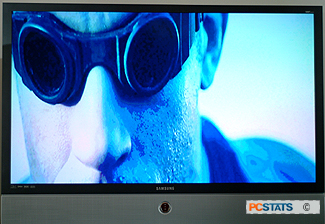 Samsung's HLN617W is built for movies, and this showed when we hooked it
up to a DVD player with component outs. DVD quality was excellent, with a very
'movie-like' feel to it (as you might expect on a 61" widescreen). The picture
was crisp and colours were vibrant and well reproduced.
Samsung's HLN617W is built for movies, and this showed when we hooked it
up to a DVD player with component outs. DVD quality was excellent, with a very
'movie-like' feel to it (as you might expect on a 61" widescreen). The picture
was crisp and colours were vibrant and well reproduced.
Using the component inputs
produced solid, respectable black, while the black from the S-video inputs was
rather washed out.
Viewing angles were quite
impressive. We did not notice much of a decrease in clarity until we moved far
enough to the side that we could not see the whole screen properly, so this will
not be a concern. Samsung advertises the set as having 160-degree viewing angles
so this is no surprise. Vertical viewing angles are a little less, but when set
up properly this shouldn't affect a users viewing experience.
Samsung's HLN617W can function
as a test case for the superiority of component inputs over S-video (not that
there was much doubt in the first place). We used a DVD player with S-video and
component outs in combination with the TV's Picture-in-picture feature to create
a half-component, half-S-video display for comparison purposes. Not only were
the colours much more vivid and life-like on the component side, the blacks were
also much deeper. There's no doubt in our mind as to what this TV needs to work
best then.
As you would expect from DLP
technology, there is no sign of 'ghosting' in the Samsung HLN617W's picture
during rapid action scenes.
The brightness of the set was
fine for darkened areas, though when we viewed the display in a normally
illuminated office area with large windows it overwhelmed the screen until we
changed to the 'dynamic' picture mode intended to deal with bright areas.
Overall we were satisfied with the brightness of this Samsung DLP
screen.

Testing with regular TV
signals always feels like a bit of a letdown on a screen this size, but the
HLN617W did not do badly. The panorama picture mode lets you use the full screen
area while only stretching the image at either edge of the screen, which we
found to be an acceptable compromise. 4.3 mode works well also, but is very
under whelming in comparison.
